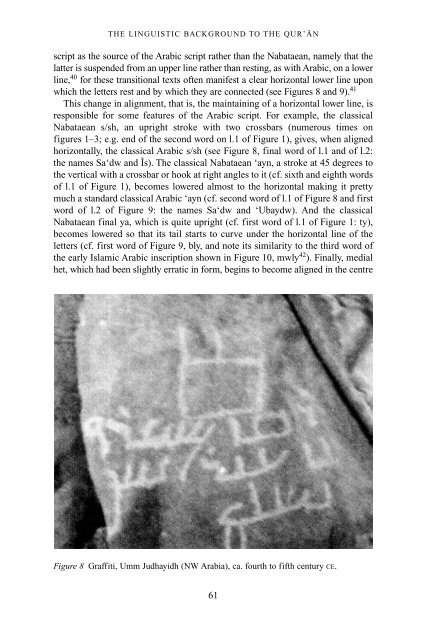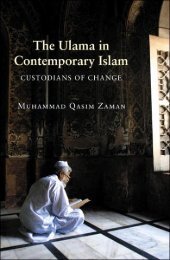- Page 3 and 4:
THE QUR’AN IN ITS HISTORICAL CONT
- Page 5 and 6:
THE QUR’AN IN ITS HISTORICAL CONT
- Page 7 and 8:
CONTENTS List of images vii Notes o
- Page 9 and 10:
IMAGES 1 Epitaph of Imru’ al-Qays
- Page 11 and 12:
CONTRIBUTORS Others Saw it (Princet
- Page 13 and 14:
FOREWORD Three decades ago, when a
- Page 15 and 16:
FOREWORD foundations of the Qur’a
- Page 17:
EGYPT Constantinople ANATOLIA Black
- Page 20 and 21:
GABRIEL SAID REYNOLDS meaning for a
- Page 22 and 23:
GABRIEL SAID REYNOLDS in kufischen
- Page 24 and 25:
GABRIEL SAID REYNOLDS beginning. It
- Page 26 and 27:
GABRIEL SAID REYNOLDS manuscripts i
- Page 28 and 29: GABRIEL SAID REYNOLDS Of these theo
- Page 30 and 31: GABRIEL SAID REYNOLDS his writing s
- Page 32 and 33: GABRIEL SAID REYNOLDS heretofore or
- Page 34 and 35: GABRIEL SAID REYNOLDS Not everyone
- Page 36 and 37: GABRIEL SAID REYNOLDS how easily th
- Page 38 and 39: GABRIEL SAID REYNOLDS Notes 1 I am
- Page 40 and 41: GABRIEL SAID REYNOLDS der Zeit durc
- Page 42 and 43: GABRIEL SAID REYNOLDS 58 Elsewhere,
- Page 45: Part 1 LINGUISTIC AND HISTORICAL EV
- Page 48 and 49: FRED M. DONNER their attitudes cons
- Page 50 and 51: FRED M. DONNER knowing what, if any
- Page 52 and 53: FRED M. DONNER forgotten and misund
- Page 54 and 55: FRED M. DONNER same basic letter-fo
- Page 56 and 57: FRED M. DONNER in Jabal Usays inscr
- Page 58 and 59: FRED M. DONNER about theology and r
- Page 60 and 61: FRED M. DONNER contrary views. John
- Page 62 and 63: FRED M. DONNER and interpretation -
- Page 64 and 65: FRED M. DONNER not have to wait for
- Page 66 and 67: FRED M. DONNER 18 F.M. Donner, “F
- Page 68 and 69: FRED M. DONNER south of Damascus, d
- Page 70 and 71: ROBERT HOYLAND Abu l-Faraj (Bar Heb
- Page 72 and 73: ROBERT HOYLAND Figure 2 Dedication
- Page 74 and 75: ROBERT HOYLAND Figure 6 Building te
- Page 76 and 77: ROBERT HOYLAND Interestingly, Arab
- Page 80 and 81: ROBERT HOYLAND Figure 9 Graffiti, U
- Page 82 and 83: ROBERT HOYLAND d Arabic had also lo
- Page 84 and 85: ROBERT HOYLAND 17-36; C. Robin, “
- Page 86 and 87: ROBERT HOYLAND when Abu Karib, a Gh
- Page 88 and 89: 3 RECENT RESEARCH ON THE CONSTRUCTI
- Page 90 and 91: GERHARD BÖWERING correlated with t
- Page 92 and 93: GERHARD BÖWERING certain consonant
- Page 94 and 95: GERHARD BÖWERING two centuries and
- Page 96 and 97: GERHARD BÖWERING for example, the
- Page 98 and 99: GERHARD BÖWERING origins of Islam.
- Page 100 and 101: GERHARD BÖWERING which the Qur’a
- Page 102 and 103: GERHARD BÖWERING 8 The Satanic ver
- Page 104 and 105: GERHARD BÖWERING 41 D. Chwolsohn,
- Page 106 and 107: 4 RECONSIDERING THE AUTHORSHIP OF T
- Page 108 and 109: CLAUDE GILLIOT influenced by the th
- Page 110 and 111: CLAUDE GILLIOT The case of Waraqa b
- Page 112 and 113: CLAUDE GILLIOT ● The (supposedly)
- Page 114 and 115: CLAUDE GILLIOT for him the “readi
- Page 116 and 117: CLAUDE GILLIOT and this can be cons
- Page 118 and 119: CLAUDE GILLIOT The same Van Reeth o
- Page 120 and 121: CLAUDE GILLIOT in Journal of Qur’
- Page 122 and 123: CLAUDE GILLIOT 29 Tabari (i.e. Bal
- Page 124 and 125: CLAUDE GILLIOT 55 Gilliot, Exégès
- Page 126 and 127: CLAUDE GILLIOT 96 Qurtubi, Tafsir,
- Page 128 and 129:
SIDNEY GRIFFITH thematic, they have
- Page 130 and 131:
SIDNEY GRIFFITH that he thinks that
- Page 132 and 133:
SIDNEY GRIFFITH While here is not t
- Page 134 and 135:
SIDNEY GRIFFITH these narratives in
- Page 136 and 137:
SIDNEY GRIFFITH the cave” (18:10)
- Page 138 and 139:
SIDNEY GRIFFITH God’s promise is
- Page 140 and 141:
SIDNEY GRIFFITH Furthermore, given
- Page 142 and 143:
SIDNEY GRIFFITH and he took the wel
- Page 144 and 145:
SIDNEY GRIFFITH al-raqim could just
- Page 146 and 147:
SIDNEY GRIFFITH heaven, the Lord
- Page 148 and 149:
SIDNEY GRIFFITH So the Qur’an’s
- Page 150 and 151:
SIDNEY GRIFFITH sources, most notab
- Page 152 and 153:
SIDNEY GRIFFITH 37 See I. Guidi,
- Page 154 and 155:
SIDNEY GRIFFITH 68 Bellam y, “Al-
- Page 157:
Part 2 THE RELIGIOUS CONTEXT OF THE
- Page 160 and 161:
SAMIR KHALIL SAMIR the parallels ar
- Page 162 and 163:
SAMIR KHALIL SAMIR interprets this
- Page 164 and 165:
SAMIR KHALIL SAMIR The verb khalaqa
- Page 166 and 167:
SAMIR KHALIL SAMIR condemnation; ev
- Page 168 and 169:
SAMIR KHALIL SAMIR Matthew and Mark
- Page 170 and 171:
SAMIR KHALIL SAMIR The Qur’anic n
- Page 172 and 173:
SAMIR KHALIL SAMIR to which Christ
- Page 174 and 175:
SAMIR KHALIL SAMIR thalathatun inta
- Page 176 and 177:
SAMIR KHALIL SAMIR To Him is referr
- Page 178 and 179:
SAMIR KHALIL SAMIR However, the pri
- Page 180 and 181:
SAMIR KHALIL SAMIR 15 See FV, 255-6
- Page 182 and 183:
SULEIMAN A. MOURAD hear all and kno
- Page 184 and 185:
SULEIMAN A. MOURAD would lead to a
- Page 186 and 187:
SULEIMAN A. MOURAD quench our thirs
- Page 188 and 189:
SULEIMAN A. MOURAD The majority of
- Page 190 and 191:
SULEIMAN A. MOURAD Conclusion The Q
- Page 192 and 193:
SULEIMAN A. MOURAD 29 The translati
- Page 194 and 195:
KEVIN VAN BLADEL The present invest
- Page 196 and 197:
KEVIN VAN BLADEL he found outside t
- Page 198 and 199:
KEVIN VAN BLADEL Egyptian metalwork
- Page 200 and 201:
KEVIN VAN BLADEL The title of the S
- Page 202 and 203:
KEVIN VAN BLADEL The second of the
- Page 204 and 205:
KEVIN VAN BLADEL relic of the True
- Page 206 and 207:
KEVIN VAN BLADEL apocalyptic terms
- Page 208 and 209:
KEVIN VAN BLADEL due to an earlier,
- Page 210 and 211:
KEVIN VAN BLADEL Floods of nations
- Page 212 and 213:
KEVIN VAN BLADEL It is tempting the
- Page 214 and 215:
KEVIN VAN BLADEL What is striking i
- Page 216 and 217:
KEVIN VAN BLADEL impossible for the
- Page 218 and 219:
KEVIN VAN BLADEL noose from the roo
- Page 220 and 221:
KEVIN VAN BLADEL (scil. Gog and Mag
- Page 222 and 223:
9 BEYOND SINGLE WORDS Ma’ida - Sh
- Page 224 and 225:
MANFRED KROPP perhaps under Indian
- Page 226 and 227:
MANFRED KROPP New examples The word
- Page 228 and 229:
MANFRED KROPP been understood as a
- Page 230 and 231:
MANFRED KROPP lame walk and the dea
- Page 232 and 233:
MANFRED KROPP round the Red Sea.”
- Page 234 and 235:
MANFRED KROPP R. Paret, Der Koran.
- Page 236 and 237:
ABDUL-MASSIH SAADI who had been at
- Page 238 and 239:
ABDUL-MASSIH SAADI having accepted
- Page 240 and 241:
ABDUL-MASSIH SAADI 22 Saadi, “The
- Page 243 and 244:
11 NOTES ON MEDIEVAL AND MODERN EME
- Page 245 and 246:
NOTES ON EMENDATIONS OF THE QUR’A
- Page 247 and 248:
NOTES ON EMENDATIONS OF THE QUR’A
- Page 249 and 250:
NOTES ON EMENDATIONS OF THE QUR’A
- Page 251 and 252:
NOTES ON EMENDATIONS OF THE QUR’A
- Page 253 and 254:
NOTES ON EMENDATIONS OF THE QUR’A
- Page 255 and 256:
NOTES ON EMENDATIONS OF THE QUR’A
- Page 257 and 258:
NOTES ON EMENDATIONS OF THE QUR’A
- Page 259 and 260:
NOTES ON EMENDATIONS OF THE QUR’A
- Page 261 and 262:
NOTES ON EMENDATIONS OF THE QUR’A
- Page 263 and 264:
NOTES ON EMENDATIONS OF THE QUR’A
- Page 265 and 266:
NOTES ON EMENDATIONS OF THE QUR’A
- Page 267 and 268:
12 SYRIAC IN THE QUR’AN Classical
- Page 269 and 270:
SYRIAC IN THE QUR’AN For classica
- Page 271 and 272:
SYRIAC IN THE QUR’AN the exegesis
- Page 273 and 274:
SYRIAC IN THE QUR’AN Nabataeans t
- Page 275 and 276:
SYRIAC IN THE QUR’AN In the case
- Page 277 and 278:
SYRIAC IN THE QUR’AN an obvious c
- Page 279 and 280:
SYRIAC IN THE QUR’AN 17 “Nabati
- Page 281 and 282:
BIBLIOGRAPHY Ibn Ishaq. See Ibn His
- Page 283 and 284:
BIBLIOGRAPHY Chronicle of Siirt, Ch
- Page 285 and 286:
BIBLIOGRAPHY Al-A‘zami, Muhammad
- Page 287 and 288:
BIBLIOGRAPHY Chwolsohn, D. Die Ssab
- Page 289 and 290:
BIBLIOGRAPHY —— “Collecte ou
- Page 291 and 292:
BIBLIOGRAPHY —— “The textual
- Page 293 and 294:
BIBLIOGRAPHY Rome: The Gregorian Un
- Page 295 and 296:
BIBLIOGRAPHY —— “Die Wissensc
- Page 297 and 298:
BIBLIOGRAPHY al-Samuk, S.M. Die his
- Page 299:
BIBLIOGRAPHY Wansbrough, J. Qur’a
- Page 302 and 303:
21:5-8 188, 192 21:20 188, 192 21:2
- Page 304 and 305:
160 227 161 238 180 242 surat al-an
- Page 306 and 307:
surat al-najm (53) 19-20 84 (n. 8)
- Page 308 and 309:
INDEX OF PEOPLE, PLACES AND SUBJECT
- Page 310 and 311:
INDEX OF PEOPLE, PLACES AND SUBJECT
- Page 312 and 313:
INDEX OF PEOPLE, PLACES AND SUBJECT



